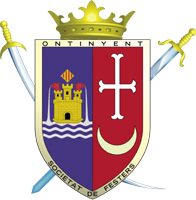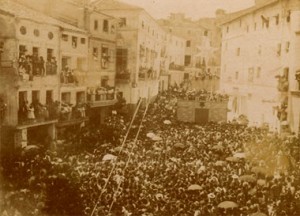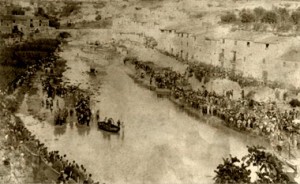The taking of Tetuan by Spanish troops and the gratitude shown to the image of Holy Christ of Agony made that the Moorish and Christians Festivities were born in 1860 in Ontinyent modelled on those occurring in other towns, despite having been shown in earlier times.
The feasts set up in three days and starring in its first year by the “comparsas” of Cruzados (Capellans), Estudiantes, Marineros and Tomasinas, by Christian armies, and Moros del Rey, Moros del Rif and Moros de Caballería, by the Saracen hordes, with their music bands, morning parades, formal parade, processions, solemn mass and simulated battle filled with its programme the August 5th, 6th and 7th between the popular rejoicing that, year after year, waited impatiently them and seeing growing the numbers of “comparsas” in its beginnings, despite different opinions, some detractors.
The adorned and illuminated villa served as the scene of this auto sacramental and saw languish, capsizing and even disappear the celebration in August or September that filled streets and squares scented with incense and burned powder due to the busy political life, economic crises and social excitement of the nineteenth century with the emergence of new cholera epidemics which sowed discouragement and the number of participants declined despite the spirits infused by the major and the parish priest of St. Charles.
Organized in the beginnings by a board composed of represents of Town Hall, Parish of St. Charles and “Llumeners”, keepers of the cult to the venerated and sallow image advocated against pests and calamities, and Porvenir Casino, the festivities is designed and organized by the Festive Society of the Holy Christ of Agony since its founding in 1880, through its board composed, among others, by a representative from each “comparsa”.
In the twilight of the century, in 1900, and counting since them with a municipal grant, the celebration continued to be governed by the same norms, in the middle of a great animation of foreign people attracted by the devotion that inspired the image, the properties of our sulphurous waters and the exhilaration of Moors and Christians made up the “comparsas” of Estudiantes, Marineros, Tomasinas, Labradores, Moros marinos, Kábilas and Turcos to present protruding news in the new twentieth century as consolidating the four festive days on August.
In the portico to the happy Twenties, new “comparsas” appeared in the festive scene, as well as a new castle in 1918, which like its two previous heard the grandiloquent verses that the laureate magistrate Joaquín José Cervino Ferrero composed expressly for our feasts in 1860 and that in its walls, in religious silence of the square turned into a real battle of shotguns and muskets, recite the Ambassadors, and whose tower flies the victorious flag after captains thrusting and cutting weapon battle.
The festivities have glad and extraordinary moments in its annals such as those experienced in 1924 with the royal concession of the title “Very Charity” or delicate when clergy were banned from their participation in the religious ceremonies in 1933, during the Second Republic, or bright when the 75th anniversary was celebrated in 1935, or sad when the Holy Christ of Agony image was burned and destroyed in the summer 1936 that led to suspend for three years the joyful events that recall medieval times. After the interruption of Spanish Civil War with their sad and painful days, the feast held easily its own organization with the blessing of the new image of the pattern of Moorish and Christians and the construction of a new fortress made of wood and burlap painted, encouraged by the Town Council and the Festive Society, whose followers were thickened with the birth of new “comparsas” in the passage of the days.
In the middle of twentieth century, the feasts 1950 lived the preamble to the remodelling of the Festive Society’s building that had the ownership of a building in the ancient Latonda Square since 1921 after staying in the Constitutional Square since its beginnings. This year (1950) Estudiantes, Labradores, Churros, Marineros, Contrabandistes and Fontanos took place in the Christian band and Moros Españoles, Benimerins, Kábilas, Moros marinos, Mozárabes and Berberiscos in the Moors with the Méndez Núñez and Almanzor frigates and Victoria corvette which in other days had their role in the disappeared “Nit del riu” and in the formal parade as artistic floats whose crew gave presents to the public such as candy and toys.
Between a blaze of gold and a river of living sensations lived in splendour the first centenary of the celebrations that prepared with illusion were very brilliant as well as those experienced in 1985 on the occasion of 125th anniversary of its establishment, after having received in 1970 the declaration of National Tourist Interest, and having hosted the Second National Congress of the Moors and Christians.
The festivities led by men and women saw amend its statutes and regulations thorough the years, modifying schedules and itineraries, incorporating women as festive members with full of rights, dignifying the different festive charges, having two new castles opened in 1948 and 1985, increasing to twelve the “comparsas” that make up each of the two hosts –Estudiantes, Guzmanes, Arqueros, Cruzados, Contrabandistas, Fontanos, Almogávares, Astures, Labradores, Cides, Marineros, Bucaneros, Moros marinos, Chanos, Omeyas, Benimerins, Abencerrajes, Kábilas, Moros españoles, Sauditas, Mudéjares, Mozárabas, Taifas and Berberiscos–, having new musician pieces composed by his/her own composers that with our prayers form the testimony of our faith and tradition.





